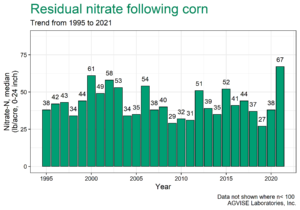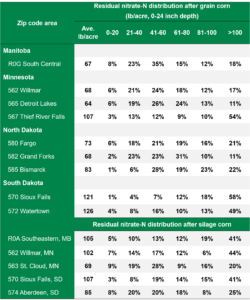How much residual soil nitrate is left after the 2021 corn crop?
It’s probably more than you think.
So far, the residual soil nitrate-nitrogen trend following corn is much higher than average across the upper Midwest and northern Great Plains. This follows the same trend set by the 2021 wheat crop. For many growers in the region, the hot and dry growing season has resulted in high residual soil nitrate-N carryover where corn yield was lower than average. An update on average residual soil nitrate-N after grain and silage corn, broken into zip code areas, can be found below (Table 1). This data highlights the importance of soil sampling for nitrate-N, even after high N-requirement crops you may not think of leaving much residual soil nitrate-N behind.
 Bar graph showing median residual nitrate-N in lb/acre for fields sampled after grain corn as of Oct. 11, 2021. Results include fields tested in MN, ND, SD, and MB. Fields tested thus far are on pace to set a record for amount of nitrate-N left after corn.
Bar graph showing median residual nitrate-N in lb/acre for fields sampled after grain corn as of Oct. 11, 2021. Results include fields tested in MN, ND, SD, and MB. Fields tested thus far are on pace to set a record for amount of nitrate-N left after corn.
The early soil nitrate-N trend data gives us a snapshot of the soil samples that AGVISE has analyzed so far. The average soil test data is not a replacement for actual soil test results on your fields or your clients’ fields. There is considerable variability within a single zip code area, with some corn fields having less than 20 lb/acre nitrate-N and many other fields that are much higher. Take a look at eastern South Dakota, the Sioux Falls and Watertown areas have over 49% of soil samples with more than 100 lb/acre nitrate-N (0-24 inch soil depth). Considering sky-high nitrogen fertilizer prices (and still rising), it makes sense to soil test for nitrate-N and credit it toward next year’s crop nitrogen budget.
Agronomic considerations for soybean in 2022
One crop that will not benefit from extra residual soil nitrate-N after corn is soybean. Soybean can create its own nitrogen thanks to a symbiotic relationship with nitrogen-fixing bacteria. The nitrogen fixation process takes energy, however, and if there is already ample plant-available nitrate in the soil, soybean will delay nodulation and take advantage of the free nitrate. Delayed nodulation may ultimately lead to soybean yield loss.
High residual soil nitrate-N can also increase soybean iron deficiency chlorosis (IDC) severity. Soybean IDC is a challenge for growers in the upper Midwest, northern Great Plains, and Canadian Prairies, especially on soils with high carbonate and salinity. If soil nitrate-N is also high, research has shown it can make soybean IDC even worse and result in lower soybean yield. If you plan to grow soybean on fields with high residual soil nitrate-N, seriously consider IDC-tolerant soybean varieties or consider planting them on fields with lower residual soil nitrate-N.
Should a corn-corn rotation be considered after a drought year and high soil nitrate?
Planting a second corn crop would allow a producer to capture this “free” nitrate-N in the soil profile. However, planting corn on corn has many challenges from soil moisture to insect pressures (e.g. corn rootworm). The 2021 corn crop started the growing season with a full profile of water (due to excessive moisture in 2019 and adequate moisture in 2020) and ended with enough to push the corn crop through harvest. Going into the 2022 growing season, plant available water will be considerably less than the beginning of 2021. If the drought continues into 2022, remember that corn requires more moisture than soybean, so planting corn on corn means putting a higher water-requiring crop on ground that had less water to start with (versus corn following soybeans). Less available moisture, combined with other agronomic pressures, may mean less than expected yield for a corn-on-corn rotation.
 Table 1. Residual nitrate trends as of Oct. 11, 2021 from more than 2,500 soil samples taken after corn. Regions with less than 60 soil samples are not included in the table.
Table 1. Residual nitrate trends as of Oct. 11, 2021 from more than 2,500 soil samples taken after corn. Regions with less than 60 soil samples are not included in the table.
